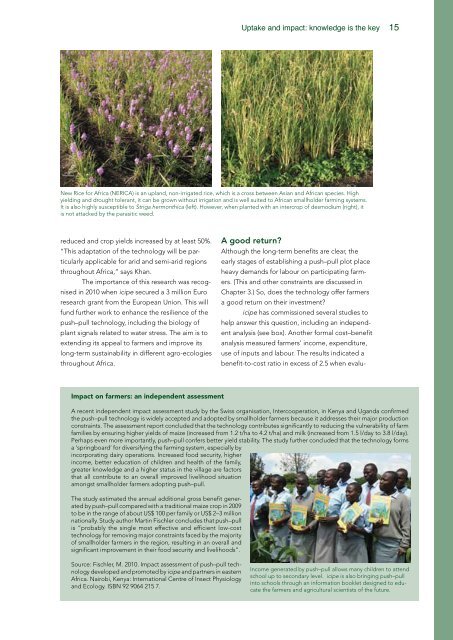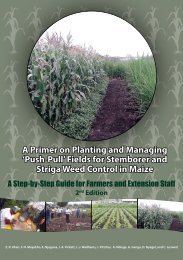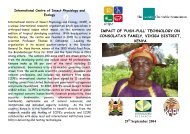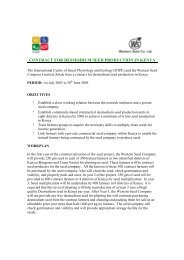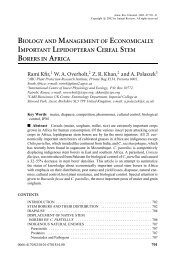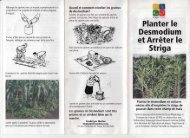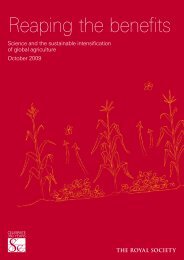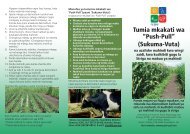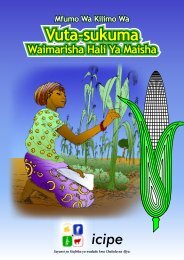a model for Africa's green revolution - Push-Pull
a model for Africa's green revolution - Push-Pull
a model for Africa's green revolution - Push-Pull
You also want an ePaper? Increase the reach of your titles
YUMPU automatically turns print PDFs into web optimized ePapers that Google loves.
Uptake and impact: knowledge is the key 15<br />
New Rice <strong>for</strong> Africa (NERICA) is an upland, non-irrigated rice, which is a cross between Asian and African species. High<br />
yielding and drought tolerant, it can be grown without irrigation and is well suited to African smallholder farming systems.<br />
It is also highly susceptible to Striga hermonthica (left). However, when planted with an intercrop of desmodium (right), it<br />
is not attacked by the parasitic weed.<br />
reduced and crop yields increased by at least 50%.<br />
“This adaptation of the technology will be particularly<br />
applicable <strong>for</strong> arid and semi-arid regions<br />
throughout Africa,” says Khan.<br />
The importance of this research was recognised<br />
in 2010 when icipe secured a 3 million Euro<br />
research grant from the European Union. This will<br />
fund further work to enhance the resilience of the<br />
push–pull technology, including the biology of<br />
plant signals related to water stress. The aim is to<br />
extending its appeal to farmers and improve its<br />
long-term sustainability in different agro-ecologies<br />
throughout Africa.<br />
A good return<br />
Although the long-term benefits are clear, the<br />
early stages of establishing a push–pull plot place<br />
heavy demands <strong>for</strong> labour on participating farmers.<br />
(This and other constraints are discussed in<br />
Chapter 3.) So, does the technology offer farmers<br />
a good return on their investment<br />
icipe has commissioned several studies to<br />
help answer this question, including an independent<br />
analysis (see box). Another <strong>for</strong>mal cost–benefit<br />
analysis measured farmers' income, expenditure,<br />
use of inputs and labour. The results indicated a<br />
benefit-to-cost ratio in excess of 2.5 when evalu-<br />
Impact on farmers: an independent assessment<br />
A recent independent impact assessment study by the Swiss organisation, Intercooperation, in Kenya and Uganda confirmed<br />
the push–pull technology is widely accepted and adopted by smallholder farmers because it addresses their major production<br />
constraints. The assessment report concluded that the technology contributes significantly to reducing the vulnerability of farm<br />
families by ensuring higher yields of maize (increased from 1.2 t/ha to 4.2 t/ha) and milk (increased from 1.5 l/day to 3.8 l/day).<br />
Perhaps even more importantly, push–pull confers better yield stability. The study further concluded that the technology <strong>for</strong>ms<br />
a ‘springboard’ <strong>for</strong> diversifying the farming system, especially by<br />
incorporating dairy operations. Increased food security, higher<br />
income, better education of children and health of the family,<br />
greater knowledge and a higher status in the village are factors<br />
that all contribute to an overall improved livelihood situation<br />
amongst smallholder farmers adopting push–pull.<br />
The study estimated the annual additional gross benefit generated<br />
by push–pull compared with a traditional maize crop in 2009<br />
to be in the range of about US$ 100 per family or US$ 2–3 million<br />
nationally. Study author Martin Fischler concludes that push–pull<br />
is “probably the single most effective and efficient low-cost<br />
technology <strong>for</strong> removing major constraints faced by the majority<br />
of smallholder farmers in the region, resulting in an overall and<br />
significant improvement in their food security and livelihoods”.<br />
Source: Fischler, M. 2010. Impact assessment of push–pull technology<br />
developed and promoted by icipe and partners in eastern<br />
Africa. Nairobi, Kenya: International Centre of Insect Physiology<br />
and Ecology. ISBN 92 9064 215 7.<br />
Income generated by push–pull allows many children to attend<br />
school up to secondary level. icipe is also bringing push–pull<br />
into schools through an in<strong>for</strong>mation booklet designed to educate<br />
the farmers and agricultural scientists of the future.


